

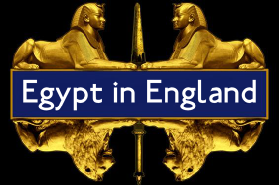

Egypt in England Newsletter
2013















Welcome to Egypt in England
As promised, the New Year has brought a change, with the first Egypt in England newsletter, and the launch of the new Egypt in England web site. The original Egyptian London web site is still on-
Gone, but not forgotten
For those of you who weren't able to make it to London to see the Egypt in England exhibition at the Quadriga Gallery in the Wellington Arch, the new Egypt in England web site has a selection of photos showing some of what was there. I'm still waiting to hear from English Heritage, but I hope that I will soon be able to include a downloadable PDF of the exhibition guide as well.
New World Pictures
The legendary film director Roger Corman, when deciding what to call his new production company, worked on the principle that the two most eye-
LEJOG
Amongst those who aspire to any serious level of cycling, Lejog, as it is known, is a rite of passage. It is an acronym for Lands End to John O'Groats, and the achievement of cycling from one to the other. For those of you who are not natives of the UK, I should probably add that they are respectively the most southern and northerly points of the British Isles. I was recently involved with the BBC History Magazine as historical consultant for an article (in the current issue, Vol 14 No. 3) on Egyptian style architecture. When they asked if it could include something in Scotland that people could visit, there was initially a problem. Cairness House in Aberdeenshire, which has what was almost certainly the first Egyptian style interior in the British Isles, is changing owners, and not currently open to the public. However, an alternative soon emerged in the shape of Noss Head lighthouse. Not only does it have definite, if rather severe, Egyptian elements, it is also close enough to John O'Groats for me to now be able to claim that the Egyptian style spread throughout the British Isles, from Lands End (well, Penzance is pretty close) to John O'Groats.
Share and Enjoy
(For those of you who remember the Hitchhiker's Guide to the Galaxy.) Do remember, if you come across anything interesting related to Ancient Egypt in England, like a forgotten piece of architecture, an intriguing piece of ephemera, or anything similar, that there is an 'Enquiries and Comment' link on the new web site menu that you can use to send me an email. I'm sure that you can come up with plenty to surprise and delight me, that I can also share in this newsletter, so don't be shy. You can remain anonymous.
Until next time,
Ankh Wedja Seneb,
Chris
A plaque for Amelia
I'm delighted to be able to tell you that despite the 34% cut in Government funding to English Heritage, with consequent effects on the Blue Plaque scheme, the last meeting of the Blue Plaques Panel has recommended that Amelia Edwards, sometimes referred to as the first woman Egyptologist, should be commemorated with her own plaque. The eventual text at 19 Wharton Street, in Clerkenwell, should read "Amelia Edwards 1831-
Egypt in Glasgow
Don't laugh, but when all this first started, well over ten years ago now, I wondered if there would be enough material for a book on London's Egyptian connections. As it turned out, the book became Egypt in England, partly because this made sense when it was being published by English Heritage, but new material keeps turning up further afield. On a recent visit to Glasgow, I managed to fit in a brief visit to the Glasgow Necropolis to see the Egyptian Vaults there, and while I haven't been able to thoroughly research and explore the Necropolis yet, I did find a very interesting obelisk monument. Unlike most of them in English and Scottish cemeteries, it not only had an Egyptian style base with battered sides and cavetto cornice, but was decorated with hieroglyphs, making it very unusual indeed. I think I may have to add a section to the Egypt in England Web Site. How does Egypt Abroad sound?
Lost Heritage?
You may have seen news recently of a major fire at the Cuming Museum in Southwark on 25th March. The full extent of losses from fire and water damage are still being assessed, although it is hoped that most of the collections, being in storage, will have survived. Richard Cuming, and his son Henry, whose collections are the basis of the museum, were not major collectors, in the sense of acquiring large and expensive items, but the sheer eclecticism of the material they amassed is part of its charm as well as its importance. On a personal level, I am hoping that one of their pieces in particular, which was on display last time I was there, will have survived. It might sound trivial, but it is a marmalade jar in the shape of Cleopatra's Needle. I don't know how many of them were originally produced, but I don't know of any others that have survived, and that alone makes it significant.
Walk (four ways) like an Egyptian
As part of the process of setting up the new Egypt in England web site, I have overhauled the range of Egyptian London walks. There are now four group walks; The Elderly Lady's Elephant, which tells the story of Cleopatra's Needle and on the way looks at mummies, camels, and seven statues of Sekhmet; Murder, Mystery, Monuments and Mummies, which looks at the British Museum's Egyptian collections in a new light; Necropolis of the North West, which looks at the many Egyptian connections of one of London's finest cemeteries; and Picture This (for all you Blondie fans), an introduction to a colourful collection of personalities connected to Egypt in the National Portrait Gallery. These walks and tours can cater for 15-
I have also taken the opportunity to make the site a little more interesting graphically, with a new sliding banner for The Elderly Lady's Elephant, and more to come for the other tours and walks. Click on the link at the top of the newsletter to check them out, and let me know what you think.
One Man's Ephemera...
I have recently acquired a couple of interesting pieces of Egyptiana. One is the cover to a piece of sheet music, the Cleopatra Galop. If you're curious what it looks and sounds like, the Bodleian Library's music scores blog has helpfully provided both the cover and a recording on line:
http://whatsthescoreatthebodleian.wordpress.com/2011/09/02/cleopatra-
Copy and paste the link into your browser.
The other item is a piece of promotional material from a south London company, based in Greenwich, advertising a product called Stu-
Until next time,
Ankh Wedja Seneb,
Chris
Enquire Within
In April's newsletter, I mentioned a brochure I had acquired for the mysterious Stu-
What interests me in particular is that the use of hieroglyphs is not simply decorative. The cartouches are readable and accurately translated, and the contents of the pamphlet are quite detailed and informative. I haven't been able to track down any more information on the product or the company, but that is not surprising. Companies often neglect their own history, and when they go out of business there is seldom much awareness of the need to preserve material or its potential importance. I was delighted to be able to track down the successor to the company that had made the polychrome tile work for the Carlton cinema in north London, and that they still had some promotional material, but my contact there said that most had simply been thrown away or destroyed when the company changed hands or was restructured and changed its name. Ephemera, by its very nature, tends to be regarded as of little intrinsic value, and because of this little of it tends to survive, but this very rarity makes it particularly interesting. How widely was this pamphlet distributed? How many people read it and were intrigued by it, or inspired to find out more about Ancient Egypt? What does it say about the values that were attached to Ancient Egypt? As always, if anyone can throw more light on this item, I would be delighted to hear from them.
Sydenham and Sphinxes
Anyone who has read Egypt in England, and wants to find out more about the Egyptian Court at the Crystal Palace should take a look at Stephanie Moser's 'Designing Antiquity', published last year by Yale University Press for the Paul Mellon Centre for Studies in British Art. (Before I get accused of 'log rolling', I should mention that although I have a copy, and she has a copy of Egypt in England, neither of them were review copies.) It isn't cheap, but it is very nicely produced, with plenty of splendid illustrations in colour and black and white, and a substantial work at over 300 pages. She is particularly interested in how the Egyptian Court relates to the wider efforts of Owen Jones to raise standards of design in 19th century Britain, and his enthusiasm for the use of colour.
To record to Future Ages these Events...
In 1802 British forces withdrew from Egypt, in theory returning it to the rule of the Turkish Sultan, but in reality leaving a power vacuum which would be filled by Muhammad Ali, an Albanian military commander who became the founder of modern Egypt. The British had tried to bring one of the two obelisks known as Cleopatra's Needles to England as a monument to the victories of Nelson and Abercrombie, but these plans failed after the jetty constructed to load it into a ship was destroyed by a storm. Wishing to leave a memorial, but aware that in the volatile political climate of the time it might be destroyed, they decided to place an inscribed plaque under the pedestal or plinth of the fallen obelisk. This was duly done, but some time in the late 1840s, or thereabouts, the granite pedestal, weighing around 40-
Fortunately, after a fair amount of detective work, I'm delighted to be able to report that the plaque has survived, and I hope to view and photograph it soon. When I do, I will put photos on the Egypt in England web site so that you can see for yourselves this obscure but significant part in the millennia long story of Cleopatra's Needle.
Until next time,
Ankh Wedja Seneb
Chris
Fixed for Future Ages?
In the last issue of this newsletter, I mentioned the plaque originally deposited under the pedestal of one of Cleopatra's Needles in Alexandria, in the words of its inscription "to Record to Future Ages These Events, And to Commemorate the Loss Sustained By the Death of Sir Ralph Abercrombey...". The plaque has had an eventful history, but as I was able to confirm this week, still survives where it was last fixed, in the entrance lobby to the former Officers' Mess of Mandora Barracks at Aldershot. Considering the amount of abuse it has had to endure over the past two hundred years and more, it is in good shape, although parts of the inscription have lost their infill and are difficult to read, and there are some dramatic gouges and scratches across its surface.
The whole Aldershot Barracks site is currently being redeveloped for housing, a process that will probably take 15-
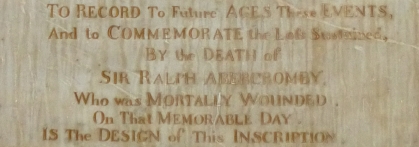
General Gordon's Camels
It all started in 2003, with a photo that showed a statue of a man on a camel in the Egyptian Court at the Crystal Palace. The man was Charles George Gordon, better known as General Gordon, 'Chinese Gordon' to his contemporaries, and after his death at the hands of the Mahdi's forces, as Gordon of Khartoum. The photo was a figure in one of the chapters in Imhotep Today, the volume on Egyptianising architecture in the series Encounters With Ancient Egypt from UCL Press, to another chapter of which I had also contributed. The presence of the statue was explained by the later role of the Egyptian Court as an exhibition space for what was then contemporary sculpture, but I was intrigued by the association of the architecture of the Ancient Egyptian empire with the statue of a British imperial hero, and its various implications. Fast forward ten years, to 2013, when I finally decided to find out more about Gen. Gordon and his camel. As always, it turned out to be far more complicated, and far more interesting, than I had imagined. For a start, there wasn't just one camel, but four of them, enough to start a small camel corps, and the statues were almost as nomadic as the animals they depicted. Their trail led from Somerset to London, then on to Kent, and from London to Khartoum and then back to Surrey, including stops at the Royal Academy and the Crystal Palace.
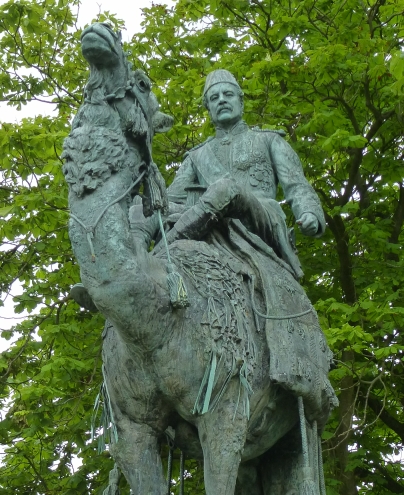 Here's the edited highlights, which include material from an article on them written by Ann Brown, a descendant of the family whose company cast the first Gordon camel statue, and who has researched their history. (The Gordonian, Issue 1, May 2013, pp. 20-
Here's the edited highlights, which include material from an article on them written by Ann Brown, a descendant of the family whose company cast the first Gordon camel statue, and who has researched their history. (The Gordonian, Issue 1, May 2013, pp. 20-
The Gordon's statue has suffered over the years, and now needs a thorough restoration. The school is currently working on raising the necessary funds, estimated at £25, 000. If you know a rich camel racing sheik, or anyone else who might be interested in sponsoring the restoration, or would like to contribute yourself, please contact Annie Hughes, the Development Director at Gordon's School:
development@gordons.surrey.sch.uk or 01276 858084
Until next time,
Ankh Wedja Seneb
Chris
Egypt in Egypt
Like so many people, when I first visited Egypt, it was to see the remains of its ancient civilisation, and while I knew I was fascinated by the Pharaohs, I wasn't sure if I would like modern Egypt. I needn't have worried, as I fell in love with the country and its people, but over the years there were always signs of the tensions just below the surface, unless you chose to ignore them. Young conscripts smiling as our minibus passed them, but still manning a machine gun at a sandbagged emplacement on a strategic turn in the road, the 'galabiyeh police' at junctions on the way to Abydos toting pump action shotguns, and noticing that the young 'customer' who a helpful Cairo café owner asked to start me off on my way towards El Azhar was carrying an automatic. It is easy, when dealing with Egypt's history and antiquities, and the influence of its ancient civilisation, to overlook what is happening in the present, but anyone who cares about the Egyptian people must hope that the current situation does not lurch back into repression, or deteriorate into sectarian chaos. Apart from the worrying rise in looting and destruction of archaeological sites, tourism was a massive contributor to the Egyptian economy, and having seen for myself the negative impact of both Gulf wars on tourism, I can only imagine how badly it is suffering currently.
Opening a can of worms
On a lighter note, it started, as so many things do, with a good idea. Initially I thought of putting a sample of text from Egypt in England up on my web site so that people could download it. Then I thought of a better way of doing it. The book is available through Amazon, and they have the 'Look Inside' feature, which allows you to browse a title. Wouldn't it be good, I thought, if people could read a sample of the book using this feature. So I suggested to this to English Heritage, and proposed that we use the Introduction as a nice self-
Camel Train
Following the tracks of General Gordon's camel (see the last issue of this newsletter) got me thinking about the way that themes emerge when you are researching an area. Camels, of course did not arrive in Egypt until after the Pharaohs, in the time of the Ptolemies, but they are still iconic symbols of Egypt. I was delighted to be able to 'bookend' Egypt in England with images of the Camel Train of Life from the gable ends of Joseph Bonomi's house in Wimbledon, 'The Camels', and then there was Gordon and his camels, and a link back to London Zoo, and that in turn made me think about other camels I had come across, including those on the arms of the Worshipful Company of Merchant Taylors. So to finish this newsletter, and to continue and broaden the theme of camels, another couple of pictures, this time from outside England. Why do they matter? Because every time a camel appears, there is a possible link to Egypt, and another sign of its continuing influence. You may have to look hard for the camel in the third one.
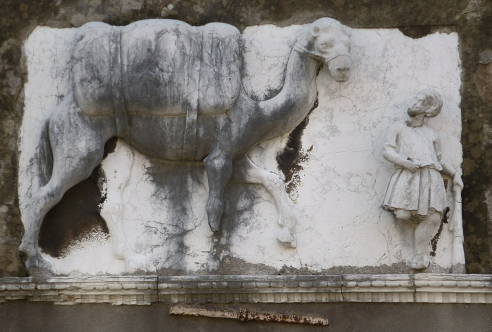
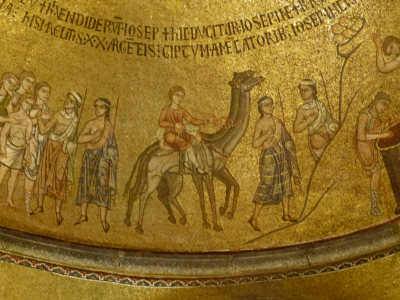
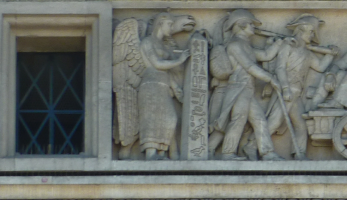
Until next time,
Ankh Wedja Seneb,
Chris
Egypt in England Study Day
I'm delighted to be able to tell you all that I have agreed with the Egypt Exploration Society to run a Study Day for them early next year. Provisional date is the 22nd March. Venue and other details to be confirmed, and the programme is still being arranged, but I'm hoping to have three other speakers; two Professors from English universities, and a distinguished international guest. Between them, they can cover an exciting range of material, which should make for a lively and stimulating day. Anyone who has already read Egypt in England needn't worry, as this is an opportunity for me to share some of the research that I've been doing since the book came out, which has taken me into a lot of new areas. More information as soon as I can.
Under Embargo
If you have ever had anything to do with press releases, you will be familiar with that phrase 'Embargoed Until...'. It's always frustrating, because it means that you know something, but can't share it. I'm in a similar position at the moment with a couple of quite significant issues that can't yet be made public because it might prejudice the outcome of discussions. However, I can tantalise you with the information that I was approached by someone who thought that they might have discovered the current location of a very important piece of Ancient Egyptian stonework, long believed lost. It would be wonderful if it had been rediscovered, and stranger things have happened, but I'm not holding out too many hopes. At the moment, it is just a battered piece of granite, largely buried in the ground, and it will take actual excavation to discover whether it is anything more than that. However, a very small sample of the granite was examined by an expert petrologist. Now granite and other hard stones are like wood, in that the size and shape of the crystals in the rock can be linked to quite specific geographical areas, and I was very surprised at his conclusions. He reckoned that it was Egyptian granite, from the Aswan area. Now, even if it isn't the long lost artefact, if he is right, what is a chunk of Aswan granite doing buried in an English park? Again, more information as soon as I can.
Camel Train Part Two
If any of you recognised the pictures of camels in last month's newsletter, you can congratulate yourselves. Two of them were from Venice, the other from Paris. From left to right, they were a relief carving set into the wall of a house in Venice known because of it as Palazzo Camello, the next one was a mosaic in one of the domes from the narthex of St Mark's Basilica, showing the story of Joseph and his brothers, and the last was from the frieze at the top of the Arc de Triomphe in Paris.
Metropolitan Monsters
Later this year, on 1st -
"Haunted ruins, cursed artefacts, arcane rituals and ambulant mummies: archaeology and the ancient world have provided some of the most effective and ubiquitous scenarios for tales of horror and the supernatural. Authors and filmmakers such as MR James, Bram Stoker and Terence Fisher have drawn heavily upon popular conceptions of both the ancient past and the work of the archaeologist. This conference aims to study and celebrate this long and productive relationship."
The programme will not be finalised until the end of this month, but it promises to be a fascinating event. Once again, more details as soon as I can.
Until next time,
Ankh Wedja Seneb
Chris
Egypt in England Study Day
The venue for this is still to be finalised, but the date should now be fixed as Saturday 22nd March 2014. Exploring the theme of Egypt in England, and the influence of Ancient Egypt on our society, will be (in alphabetical order); Professor Edward Chaney, of Southampton Solent University, Dr Jean-
Try Before You Buy
After a considerable amount of work, I'm hoping that before long Egypt in England can be browsed on Amazon using the 'Look Inside' feature. (For details, see 'Opening A Can of Worms' in the July issue of the newsletter.) All the rights holders have now kindly given their agreement, and the rest of the process should be fairly straightforward. English Heritage are also looking at a similar feature, but one which is independent of Amazon, which they can use on their own web site. However tempting a title looks, there is nothing like being able to sample it to decide if it is one that you want to have a copy of, and it will be nice for people to finally be able to do this with Egypt in England.
Print or Pixels?
On a slight tangent, I have been asked whether there will be a Kindle version of Egypt in England. A very good question, as they say. The short answer is; not at present. One of the main reasons is that all the rights holders for illustrations would need to be contacted again, and fresh agreement reached for use in an electronic version of the title. There would also be cost implications, as most of them would charge an additional fee for this sort of use.
More generally, publishing in general, and academic publishing in particular, are in a state of turmoil at the moment, and no-
Where does this leave academic and accessible academic titles? Speaking personally, I find it enormously valuable to be able to access material in PDF or other digital format, and to take it around with me on my Kindle Fire, but I still have a bookcase of Egyptological titles within arm's reach. As more and more titles fall out of copyright, they are increasingly available in digital form, through Project Gutenberg and the like, but the accuracy of texts often leaves a lot to be desired. Will people still be prepared to pay for the quality control represented by professionally edited and published texts, and will they still value books as physical objects, in addition to the information they contain? No-
Until next time,
Ankh Wedja Seneb,
Chris
Egypt in England Seminar
Those of you who are members of the Egypt Exploration Society (EES) will before too long be receiving the next Newsletter, with details of the forthcoming Egypt in England seminar. (Not Study Day, as I mistakenly referred to it previously.) The event is definitely also open to non-
http://www.pandemonium-
Try...just a little bit harder
(How many of you spotted the Janis Joplin lyric there?) In the last newsletter, I was cautiously confident that you would soon be able to browse Egypt in England through Amazon's 'Look Inside' feature. Frustratingly, all the rights holders have given their agreement, and English Heritage have sent the PDF of the book to Amazon, but the mighty river of digital commerce is flowing rather sluggishly, and it hasn't actually happened yet. It should be imminent, but don't ask me to put a time scale on that.
It's Egyptian, Jim, but not as we know it.
Just this morning, I received the proofs of my article for the Journal of Egyptian Archaeology on 'Compositions in Egyptian Hieroglyphs in Nineteenth Century England', which should appear in the 2013 edition of the Journal. (Which, in the way of these things, will actually come out in 2014.) It allowed me to look at four inscriptions connected with buildings featured in Egypt in England, which were modern texts written in hieroglyphs. (Basically dedicatory texts mentioning Queen Victoria.) Although it is necessarily fairly technical in places, it was written to be as accessible as possible, if you can get access to the JEA.
Egyptian Empires
Also imminent as I write this is a piece that I did for New Empress Magazine, a fresh and very attractive film magazine and web site:
http://newempressmagazine.com/
Their next issue is a location special, and I did an article for them on London's Egyptian film locations. With, I have to confess, not one but two punning references to Schwarzenegger films. (Not Egyptian themed, but he did once live in the same street as I do, although not at the same time, so that was my justification.) They normally make one article from each issue freely available to promote the magazine and site, and the Editor in Chief has very generously selected mine for the next issue, which means that before long I can put it up on the Egypt in England web site for you to read and/or download.
Until then, and until next time,
Ankh Wedja Seneb
Chris
CSI Thebes -
Tutankhamun is television catnip. Stick his name in anything, and you are almost guaranteed an audience. I watched the recent Channel 4 documentary 'Tutankhamun: The Mystery of the Burnt Mummy', largely because it was presented by Chris Naunton, Director of the Egypt Exploration Society, previously seen in an excellent and long overdue documentary on Flinders Petrie. (Who couldn't really be described as TV catnip, but deserves to be much better known.) If you didn't watch or record the Tutankhamun documentary, you should still be able to get it on-
We'll come back to the burnt mummy in a minute, but for me one of the most interesting things about the programme was that it didn't just look at how Tutankhamun died, but turned its attention to the elephant in the corner in the case of this famous fatality. Almost as soon as his mummy was exposed, and an autopsy carried out by Douglas Derry, theories began to proliferate about how the boy-
The second theme in the documentary, which gave it its title, was the poor state of preservation of the mummy, and the hypothesis that the soot-
Although you wouldn't have guessed it from the title, the documentary also looked at whether Tutankhamun's tomb had been usurped by Ay, and Tutankhamun buried in Ay's tomb. Again, not really controversial, as Tutankhamun's actual tomb, KV62, is often considered to be an adapted private tomb, and is the only tomb in the Valley of the Kings whose reliefs show the funeral procession, commonly shown in private tombs of the period. The decoration in Ay's tomb in the West Valley (WV23) is similar to that in Tutankhamun's, but while suggestive, none of this evidence is strong enough to make usurpation of the planned royal tomb by Ay the only tenable explanation.
Lastly, the programme looked at how Tutankhamun's tomb had come to survive relatively intact. (Not intact, as is often stated. It was robbed twice in ancient times.) It was suggested that this was because it had been covered by debris from one of the flash floods that periodically scour the Valley, and overlooked because of this. The entrance to Tutankhamun's tomb was buried by chippings from the excavation of the tomb of Ramesses V/VI (KV9), which was constructed around 170 years later, and by the time the later tomb was excavated the earlier one might have been buried and overlooked. Again, interesting, but did Carter have to clear debris from flash floods, which we were told would be as hard as concrete, before exposing the tomb entrance? A simple question, but one that wasn't asked or answered in the programme.
More than enough material, and interesting material at that, for one documentary, but why did it have to be a 'Mystery'? You could say that archaeology is all about mysteries -
Until next time,
Ankh Wedja Seneb
Chris



























December
Egypt in England Seminar
Details of the seminar, which has been covered in previous Egypt in England newsletters, were sent out with the last Egypt Exploration Society newsletter, and places can now be booked through the EES web site, at the following address:
http://www.ees.ac.uk/events/index/247.html
22nd March 2014, 11am to 4pm at the wonderfully atmospheric Egypt Exploration Society in Doughty Mews. Places will be limited, so book early. With such a variety of speakers and topics, it should be more than just the sum of its parts.
I've a feeling we're not in Thebes any more...
The print edition of Issue 12 of New Empress Magazine is now available to order online, and will be sent out on 23rd December. It is their Locations in Film Edition, and as well as articles on The Geography of Horror, What Happened in Sunnydale and Fantasy Film Locations, it has my article on Egyptian London on Film. It also has a splendid cover, which you can check out here:
http://newempressmagazine.com/2013/12/issue-
Compliments of the Season
You will, I am sure, be glad that I resisted the fleeting temptation to plaster a Santa Claus hat on the Egypt in England sphinxes, or to spatter the newsletter with other festive bling. There is, after all, nothing Ancient Egyptian about Christmas. Even their seasons were different. You could point out that there is the account in the Gospel of Matthew of the Flight into Egypt of the Holy Family, and that Egypt played a crucial role in the development of Christianity as a religion, but that is rather clutching at straws. Our Christmas in England is more about the winter solstice, heavily embellished with Dickensian elements drawn from his childhood experience of unusually cold and snowy winters. However, before I am accused of channelling the spirit of Ebenezer Scrooge, let me offer you a couple of small festive gifts. There is a new section on the Egypt in England web site, Egypt in Print, which will feature various articles on ways in which our culture has been influenced by that of Ancient Egypt. The first of these, which has kindly been made available by Discover Britain magazine, is an article that I wrote for them last year about Egyptian style architecture, and which can be downloaded for personal or educational use in PDF form. For those of you that don't already know it, I will also leave you with Mathilde Blind's poem about Cleopatra's Needle, To the Obelisk During the Great Frost, 1881, with the sincere hope that this winter is not as bad as the one she describes:
“Thou sign-
Once fronting in thy monumental pride
Egypt's fierce sun, that blazing far and wide,
Sheared her of tree and herb, till like a disk
Her waste stretched shadowless, and fraught with risk
To those who with their beasts of burden hied
Across the seas of sand until they spied
Thy pillar, and their flagging hearts grew brisk:
Now reared beside our Thames so wintry grey,
Where blocks of ice drift with the drifting stream,
Thou risest o'er the alien prospect! Say,
Yon dull, blear, rayless orb whose lurid gleam
Tinges the snow-
Is this the sun which fired thine orient day?”
Until next time, however you celebrate this time of year, for whatever reason and in whatever way, let me wish you the compliments of the season in a way that the Ancient Egyptians would have understood.
Ankh Wedja Seneb
Chris
| The Elderly Lady's Elephant |
| Murder, Mystery, Monuments and Mummies |
| Necropolis of the North West |
| Picture This |
| Newsletter subscription form |
| Egypt in England Newsletter 2016 |
| Egypt in England Newsletter - 2015 |
| Egypt in England Newsletter 2014 |
| Egypt in England Newsletter - 2013 |